NVIDIA Shield Review: At the Crossroads of PC and Mobile Gaming
by Brian Klug on July 31, 2013 12:14 AM ESTGPU Performance - 3DMark
The GPU performance story is finally a competitive one for NVIDIA. Although Tegra 4 lacks full OpenGL ES 3.0 compliance, it does finally dedicate enough SoC die area to GPU performance to compete with the likes of Apple and the iPad with Retina Display. We'll start with 3DMark, which is Android and Windows only at this point.
3DMark for Android features the Ice Storm benchmark and uses OpenGL ES 2.0. Ice Storm is divided into two graphics tests and a physics test. The first graphics test is geometry heavy while the second test is more pixel shader intensive. The physics test, as you might guess, is CPU bound and multithreaded. The overall score takes into account both graphics and physics tests. The benchmark is rendered to an offscreen buffer at 720p/1080p and then scaled up to the native resolution of the device being tested. This is a very similar approach we've seen by game developers to avoid rendering at native resolution on some of the ultra high resolution tablets. The beauty of 3DMark's approach here is the fact that all results are comparable, regardless of a device's native resolution. The downside is we don't get a good idea of how some of the ultra high resolution tablets would behave with these workloads running at their native (> 1080p) resolutions.
Here we see Tegra 4 in Shield outperforming all of the shipping players on Android, and virtually tying with Adreno 330 in Qualcomm's upcoming MSM8974 (Snapdragon 800 platform). Tegra 4's GPU performance is still no where near even Intel's HD 4000, but we're seeing massive improvements in raw FP throughput in ultra mobile GPUs. I'm very eager to see what's possible once Kepler makes its way into NVIDIA's mobile SoCs next year with Logan.
The 3DMark Physics test is also worth looking at as it shows a 36% increase in performance over four Krait 300 cores running at 1.5GHz. There are faster Krait 300s out there, but another 13% isn't enough to make up this gap. The Krait 400 comparison is much closer, but the Krait 400s have to be clocked at 2.3GHz to equal the performance of the 1.9GHz Cortex A15s. It remains to be seen which combination is ultimately lower power.
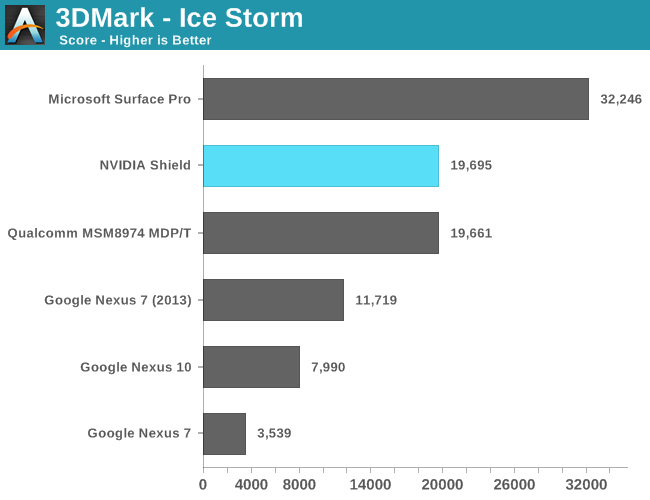

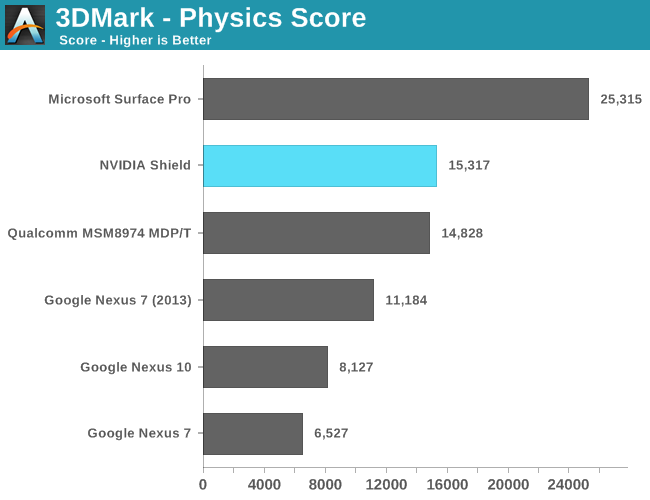
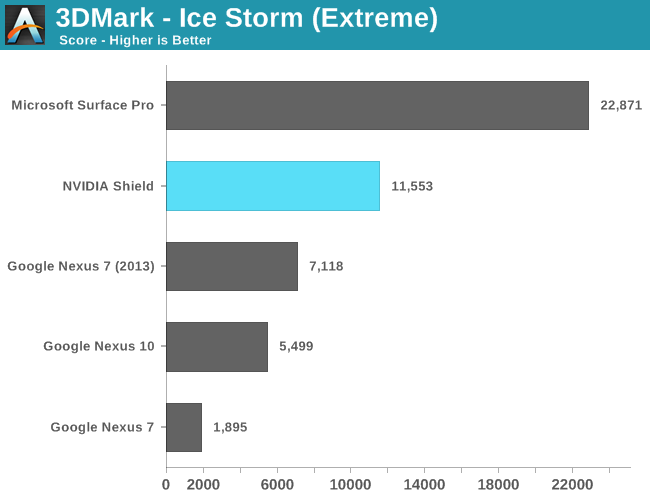
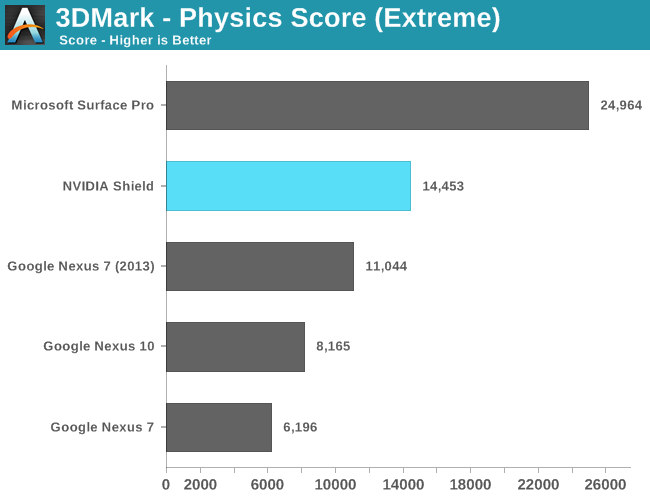

Basemark X
Basemark X is a new addition to our mobile GPU benchmark suite. There are no low level tests here, just some game simulation tests run at both onscreen (device resolution) and offscreen (1080p, no vsync) settings. The scene complexity is far closer to GLBenchmark 2.7 than the new 3DMark Ice Storm benchmark, so frame rates are pretty low.
In both tests, NVIDIA posts big gains over anything presently shipping from the Android camp. Adreno 330 pulls ahead on a level playing field, holding a 24% performance advantage over Tegra 4.
I would've loved to have seen this sort of competition from NVIDIA back when the iPad 4 launched, but it's at least good to see NVIDIA move from being a value player with Tegra 3 to a high performance contender with Tegra 4.
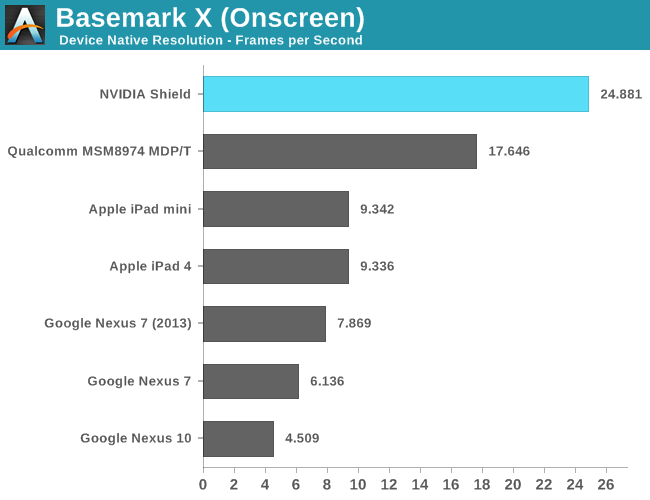











134 Comments
View All Comments
blanarahul - Wednesday, July 31, 2013 - link
Get the new Nexus 7. It has a larger screen so on screen controls won't be too bad. OpenGL ES 3.0 support is a big plus too.kmmatney - Wednesday, July 31, 2013 - link
On screen controls suck even on the much larger iPad. Emulators support RF controllers like the Wii Controller, but not enough official games do.varad - Wednesday, July 31, 2013 - link
Gamestop will probably have both devices on display. So you should be able to play with both and decide which one you like better!psuedonymous - Wednesday, July 31, 2013 - link
Much as I love the idea of the local streaming feature, you might be better served at this point with a Nexus 7, a DualShock 3 and a Gameklip.JeffFlanagan - Wednesday, July 31, 2013 - link
Thanks for mentioning the Gameklip. I hadn't heard of it, and just ordered one with cases for my Nexus 7 and Galaxy Note, in case the Nexus 7 is too top heavy to game comfortably.Subzero0000 - Thursday, August 1, 2013 - link
You should get Nexus 7. 'cus you can read online comfortably, and play some games occasionally. Buy a Android compatible controller if you must.Reading on the Shield is not going to be nice with the controller attached (unremovable) to it.
boozed - Wednesday, July 31, 2013 - link
Probably should rephrase the beginning of that second para to "It’s no secret that Tegra isn’t exactly the success that NVIDIA probably hoped it would be."Krysto - Wednesday, July 31, 2013 - link
Brian. The delay of Tegra 4 most likely not the main reason why Google didn't go with them this time. There are other more important reasons, such as"1) no LTE for Tegra 4, and Google wanted LTE for Nexus 7, one that works on all carriers
2) no OpenGL ES 3.0 support - was one of the main features of Android 4.3
3) S4 Pro is probably close to half the price of Tegra 4. If they wanted a more expensive chip, they could've gone with S600 at the very least
4) Power consumption might've played a role there, too. We need to see how Tegra 4 does in a tablet, although I honestly can't consider a chip a "mobile chip" if it can't be put in a smartphone because of too high power consumption.
SydneyBlue120d - Wednesday, July 31, 2013 - link
Well, let's take a look at the comments about Toshiba Excite Pro, the first sipping Tablet with Tegra 4 onboard, Toshiba Excite Pro http://amzn.com/B00D78Q2NQ :- I would have most definitely kept the tablet, had it not overheated. I realize that some overheating will hsppen under normal use. However, I was quite concerned when the unit overheated a lot after only 20 or 30 minutes of use.
- Runs extremely hot. After 10-15 mins playing light games or watching Netflix, its crazy hot
- It's overheat when play any game for 10mins
Ok, we don't know if it is Toshiba fault, however the fact that event on the shield it is running a fan, should sound quite dangerous...
Spunjji - Wednesday, July 31, 2013 - link
My thoughts exactly. I can't for a second believe that the chip can hold up its performance levels in a thermally constrained without something giving; something either being the ability to run cool or the performance itself.